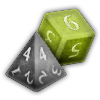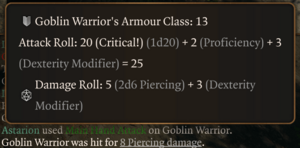Ad placeholder
Damage: Difference between revisions
(→Damage types: Explain the concept of "weapon damage.") |
(Removed the misleading part about "two-handed" weapons rolling two dice as there are single-handed weapons that do that too, such as BOOOAL's Sickle or Shadow Blade.) |
||
| (One intermediate revision by one other user not shown) | |||
| Line 15: | Line 15: | ||
==== Example ==== | ==== Example ==== | ||
A successful attack with a {{WeaponIcon|Daggers}} [[Daggers|Dagger]] does a base of {{DamageText|1d4|Piercing}} damage (1~4). This means a single four-sided die [[File:D4_Piercing.png|20px|link=]] is rolled to determine the damage, for a total of 1 to 4 piercing damage. Most weapons use a single damage die, but some | A successful attack with a {{WeaponIcon|Daggers}} [[Daggers|Dagger]] does a base of {{DamageText|1d4|Piercing}} damage (1~4). This means a single four-sided die [[File:D4_Piercing.png|20px|link=]] is rolled to determine the damage, for a total of 1 to 4 piercing damage. Most weapons use a single damage die, but some weapons use two: a successful attack with a {{WeaponIcon|Greatswords}} [[Greatswords|Greatsword]] does {{DamageText|2d6|Slashing}} damage (2~12), rolling two six-sided dice [[File:D6_Slashing.png|20px|link=]] for a total of 2 to 12 slashing damage. Damaging spells typically roll more dice: for example, being caught in a {{SAI|Fireball}} will cause {{DamageText|8d6|Fire}} damage (8~48), though a successful [[Saving Throw]] can reduce it to half. | ||
=== Attacks === | === Attacks === | ||
| Line 29: | Line 29: | ||
All damage has a ''damage type'', of which there are 13: | All damage has a ''damage type'', of which there are 13: | ||
<gallery mode="nolines" heights="40px"> | <gallery mode="nolines" heights="40px" style="text-align:center"> | ||
Bludgeoning Damage Icon.png|{{DamageColor|Bludgeoning|Bludgeoning}} | Bludgeoning Damage Icon.png|link=Bludgeoning|{{DamageColor|Bludgeoning|Bludgeoning}} | ||
Piercing Damage Icon.png|{{DamageColor|Piercing|Piercing}} | Piercing Damage Icon.png||link=Piercing|{{DamageColor|Piercing|Piercing}} | ||
Slashing Damage Icon.png|{{DamageColor|Slashing|Slashing}} | Slashing Damage Icon.png||link=Slashing|{{DamageColor|Slashing|Slashing}} | ||
Cold Damage Icon.png|{{DamageColor|Cold|Cold}} | Cold Damage Icon.png||link=Cold|{{DamageColor|Cold|Cold}} | ||
Fire Damage Icon.png|{{DamageColor|Fire|Fire}} | Fire Damage Icon.png||link=Fire|{{DamageColor|Fire|Fire}} | ||
Lightning Damage Icon.png|{{DamageColor|Lightning|Lightning}} | Lightning Damage Icon.png||link=Lightning|{{DamageColor|Lightning|Lightning}} | ||
Thunder Damage Icon.png|{{DamageColor|Thunder|Thunder}} | Thunder Damage Icon.png||link=Thunder|{{DamageColor|Thunder|Thunder}} | ||
Acid Damage Icon.png|{{DamageColor|Acid|Acid}} | Acid Damage Icon.png||link=Acid|{{DamageColor|Acid|Acid}} | ||
Poison Damage Icon.png|{{DamageColor|Poison|Poison}} | Poison Damage Icon.png||link=Poison|{{DamageColor|Poison|Poison}} | ||
Radiant Damage Icon.png|{{DamageColor|Radiant|Radiant}} | Radiant Damage Icon.png||link=Radiant|{{DamageColor|Radiant|Radiant}} | ||
Necrotic Damage Icon.png|{{DamageColor|Necrotic|Necrotic}} | Necrotic Damage Icon.png||link=Necrotic|{{DamageColor|Necrotic|Necrotic}} | ||
Force Damage Icon.png|{{DamageColor|Force|Force}} | Force Damage Icon.png||link=Force|{{DamageColor|Force|Force}} | ||
Psychic Damage Icon.png|{{DamageColor|Psychic|Psychic}} | Psychic Damage Icon.png||link=Psychic|{{DamageColor|Psychic|Psychic}} | ||
</gallery> | </gallery> | ||
Latest revision as of 10:18, 4 August 2024
Damage is a number that represents how deadly a threat is. When a creature takes damage, they subtract that amount of damage from their current amount of hit points.
Damage is dealt with attacks and other harmful actions, as well as by a variety of conditions.
Damage rolls[edit | edit source]
The base damage dealt by a weapon, spell, class action, or condition is usually determined by a damage roll. Damage rolls always have an associated damage type that is given following the dice notation, e.g. .
Damage modifiers[edit source]
Modifiers added to damage rolls are only added per source, even if multiple dice are rolled.
Which ability score modifier is added to a damage roll depends on the attack:
- When making weapon attacks, the attacking creature usually adds their ability score modifier to the attack roll.
- Ability score modifiers are not normally added to damage rolls dealt by spells or spell attacks, unless specifically stated otherwise in the spell's description, or if enabled by some feature, such as .
Example[edit | edit source]
A successful attack with a ![]() Dagger does a base of 1d4
Dagger does a base of 1d4![]() Piercing damage (1~4). This means a single four-sided die
Piercing damage (1~4). This means a single four-sided die ![]() is rolled to determine the damage, for a total of 1 to 4 piercing damage. Most weapons use a single damage die, but some weapons use two: a successful attack with a
is rolled to determine the damage, for a total of 1 to 4 piercing damage. Most weapons use a single damage die, but some weapons use two: a successful attack with a ![]() Greatsword does 2d6
Greatsword does 2d6![]() Slashing damage (2~12), rolling two six-sided dice
Slashing damage (2~12), rolling two six-sided dice ![]() for a total of 2 to 12 slashing damage. Damaging spells typically roll more dice: for example, being caught in a will cause 8d6
for a total of 2 to 12 slashing damage. Damaging spells typically roll more dice: for example, being caught in a will cause 8d6![]() Fire damage (8~48), though a successful Saving Throw can reduce it to half.
Fire damage (8~48), though a successful Saving Throw can reduce it to half.
Attacks[edit | edit source]
In order to damage a target when making an attack, creatures must first make an attack roll. Attack rolls are rolled against the target's AC. If the attempt is successful, the attack hit, and the attacker rolls for damage. If the result was less than the target AC, the attack was a miss.
Attack roll modifiers[edit | edit source]
Attack rolls are always made using an associated ability:
- Unarmed attacks, and attacks made with melee weapons and thrown weapons generally add the attacking creature's Strength modifier.
- If the weapon has the Finesse property, attacks with it add either the attacker's Strength or Dexterity modifier, whichever is higher.
- Unarmed attacks may use the attacker's Dexterity modifier if they have certain features like Dextrous Attacks from the Monk class.
- Attacks made with ranged weapons add the creature's Dexterity modifier.
- Spell attacks add the caster's spellcasting ability modifier, generally determined by their class.
Critical hits[edit | edit source]
When a creature rolls a natural 20 on an attack roll, the attack is a critical hit. Critical hits automatically land regardless of the target's AC, and the attacker also rolls twice the normal number of dice to determine damage dealt, including additional dice such as those from smites or combat maneuvers. Modifiers and bonuses – including the creature's relevant ability score modifier and proficiency bonus – are not doubled.
Some feats, class features, and items reduce the critical hit threshold by 1, allowing the creature to land critical hits by rolling either 19 or 20 on attack rolls. Multiple sources of this effect stack, allowing the critical hit threshold to go even lower than 19.Damage types[edit | edit source]
All damage has a damage type, of which there are 13:
Bludgeoning, piercing and slashing damage are sometimes collectively referred to as Physical damage. Almost all weapons, melee or ranged, deal one of the physical damage types, although there are exceptions such as the Ne'er Misser.
The wiki sometimes uses the term Weapon damage when the type of damage is based on the primary damage type of the weapon being used. This is almost always one of the physical damage types, but can be something else in rare cases. For example, after casting Hunter's Mark on an enemy, an attack with most longswords would deal additional slashing damage, and an attack with most hand crossbows would deal additional piercing damage. However, an attack with the Ne'er Misser would deal additional force damage, because the Ne'er Misser uses force as its primary damage type. Another example would be using Sneak Attack with a Flame Blade or Shadow Blade, which would make the sneak attack deal fire or psychic damage, respectively.
If a source of damage mixes different sizes of dice or damage types, they will be listed separately with a plus sign between them, e.g. 1d8![]() piercing + 1d4
piercing + 1d4![]() fire. Each type is dealt separately, though see damage mechanics for more details.
fire. Each type is dealt separately, though see damage mechanics for more details.
Resistance, Vulnerability and Immunity[edit | edit source]
A creature's resistances determine which damage types they are immune, resistant or vulnerable to:
- Damage dealt to a creature with resistance to that damage type is halved.
- Damage dealt to a creature with vulnerability to that damage type is doubled.
- Damage dealt to a creature with immunity to that damage type is reduced to zero.
Resistance and vulnerability to the same type cancel each other out, but don't affect immunity.
A bit of mathematics[edit | edit source]
Note that due to the mathematics of dice rolls, the difference between, say, 1d8 and 2d4 is more than just the higher minimum value of 2 on the 2d4 roll. With the d8, you have an equal chance of getting, say, a 5 and an 8. On the other hand, the 2d4 roll is statistically more likely to lead to a total value of 5, than a total value of 8. This is most easily explained with a table of all possible outcomes:
| + | 2nd roll | ||||
|---|---|---|---|---|---|
| 1 | 2 | 3 | 4 | ||
| 1st roll | 1 | 2 | 3 | 4 | 5 |
| 2 | 3 | 4 | 5 | 6 | |
| 3 | 4 | 5 | 6 | 7 | |
| 4 | 5 | 6 | 7 | 8 | |
Notice how often the 5 appears in the possibilities for the total value (4 out of 16 possibilities) vs. how often the 8 appears (1 out of 16). This means a 2d4 roll has a 25% chance of resulting in 5 points of damage, but only a 6.125% chance of resulting in 8 points of damage. Meanwhile, the 1d8 roll actually has a higher chance of resulting in the maximum damage value of 8, since 1 out of 8 possibilities (12.5%) result in an 8. However, the average roll of 2d4 is 5 damage, while the average roll of 1d8 is only 4.5, because 2d4 can never roll a 1. Therefore, 2d4 is generally more consistent in damage output and will result in higher rolls in the long run.
See also[edit | edit source]
Footnotes[edit | edit source]

